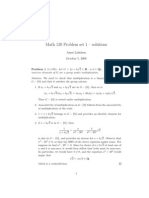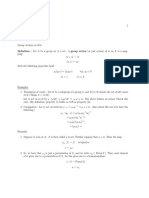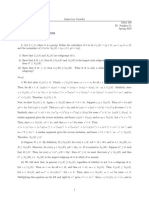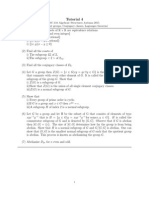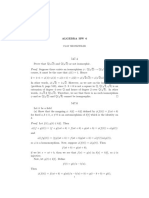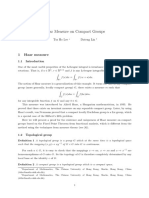Tutorial 3 So Lns
Tutorial 3 So Lns
Uploaded by
pankajOriginal Description:
Copyright
Available Formats
Share this document
Did you find this document useful?
Is this content inappropriate?
Report this DocumentCopyright:
Available Formats
Tutorial 3 So Lns
Tutorial 3 So Lns
Uploaded by
pankajCopyright:
Available Formats
Tutorial 1
SC-116 Algebraic Structures Autumn 2015
(Groups and Subgroups)
4. Show that if : G H is an isomorphism then |x| = |(x)|, x G.
Solution : Let x G be of order n, then xn = 1.
Now, (x)n = (xn ) = 1. So, |(x)| divides n, (by Lagranges Theorem).
Now, assume |(x)| = m then m|n and (x)m = 1 (xm ) = 1. Since, is one-one
and (1) = 1 so xm = 1 which imply m = n.
3. .
Solution : Given that G H is an isomorphism.
() Assume G is abelian. Let a, b H.
Then, x, y G such that (x) = a, (y) = b, since is surjective.
Now, ab = (x)(y) = (xy) = (yx) = (y)(x) = ba. Hence, H is abelian.
() Now, assume H is abelian.
Let x, y G. Then, (xyx1 y 1) = (xy)(x1)(y 1) = (xy)(y 1)(x1 ) =
(xyy 1x1 = (1) = 1.
Since is one-one so xyx1 y 1 = 1 xy = yx. Hence G is abelian.
1. .
Notice in question no. 4 that |x| = |(x)|. So, whatever map we define here will
preserve this property. Actually, isomorphism preserves all the properties of a group,
say G, isomorphic to any group, say H.
Solution : Define f : Z9 Z6 such that f (2k ) = k.
a) To prove f is well-defined.
Let 2k = 2l . That means [2k ] = [2l ], so (2k )i = 2l for some i Z. Thus, ki = l.
Again, [k] = [l], since (k)i = ki = l. (Note the operation is addition, so k i = ki).
Hence, f (2k ) = f (2l ). This imply f is well defined function.
b) f is homomorphism.
f (2k 2l ) = f (2k+l) = k + l = f (2k ) + f (2l ).
c) Trace back proof in part a), then f is one-one.
d) Let k Z6 then 2k Z9 such that f (2k ) = k. Hence, f is onto.
Thus, f is isomorphism or Z9
= Z6 .
2. .
As we have learned from previous problems that properties of a group under isomorphism is preserved. And, since we know Z6 is cyclic so all we had to do was to find
a generator in Z9 , and we were done.
1
Solution : There are 7 non-identity elements. So, do not think of multiplying every
element 8 times because that will lead to 7 8 calculations. Instead we apply logic.
We know |x| divides 8 (x 6= 1). So, possible orders of x is 2, 4, 8. So, just find x2 and
x4 . If some element say y does not become 1 then order of that y has to be 8 and
hence its a generator. This reduces our number of calculation to 7 2 = 14.
Look closely in this case. If x2 = 1 then x4 = 1 since x4 = (x2 )2 . So, just calculate
x4 . And this further reduces our calculation to 7 times.
Since, there are no generators, so Z20 is not isomorphic to Z8 .
5. .
Let g G. Define f : G G by f (x) = gxg 1.
claim : f is an isomorphism.
Let x = y then gx = gy gxg 1 = gyg 1 f (x) = f (y). So, f is well-defined
map. Now, if we trace back we prove f is one-one.
Given y G consider x = g 1 yg. We get f (x) = y. Thus, f is onto.
Now, f (xy) = g(xy)g 1 = gxg 1gyg 1. Thus, f is homomorphism.
Hence, f is an isomorphism.
Note that for every g, we get and automorphism. So, if |G| = n then we get atleast
n automorphisms.
( I have skipped small steps like Let x, y G, using associative property, by Lagranges theorem, etc. So, in exam you are expected to write it wherever necessary.
6. .
Let f : G G be defined by f (x) = x1 .
Clearly, f is a bijection (prove it).
Claim : f is an automorphism.
() Assume f is an automorphism.
f (xy(yx)1) = f (xy)f ((yx)1) = f (xy)yx = f (xy)f (y 1)f (x1 ) = f (xyy 1x1 ) =
f (1).
Thus xy(yx)1 = 1 xy = yx. Thus, G is abelian.
(Note that you have to mention where you used homomorphism and one-one map
property).
() Assume G is abelian.
We have xy = yx. f (xy) = f (yx) = (yx)1 = x1 y 1 = f (x)f (y). Thus, f is an
isomorphism.
7. .
Given that :
a) H, K G
b) H K =
c) HK = G
d) hk = kh h H, k K.
Claim : G
= H.
(Note that HK = {hk : h H, k K} and H K = {(h, k) : h H, k K}. And,
operation in H K is coordinate-wise, i.e (h, k)(h , k ) = (hh , kk ).
Define f : G H K by f (g) = (h, k) for some h H, k K.
i) To check f is well-defined.
Let g = g , then by (c), h, h1 H, k, k1 K such that g = hk and g = h1 k1 . So,
1
hk = h1 k1 h1
= 1, by (b). Thus, h = h1 and k = k1 . So, f (g) = f (g ).
1 h = k1 k
ii) To check f is one-one.
f (g) = f (g ) (h, k) = (h1 , k1 ) h = h1 , k = k1 g = g .
(Note that without proving (i) you can not claim (ii).)
iii) Check f is onto.
iv) To check f is homomorphism.
f (g1g2 ) = f ((h1 k1 )(h2 k2 )) = = f (h1 h2 k1 k2 ) = (h1 h2 , k1 k2 ) = (h1 , k1 )(h2 , k2 ) =
f (g1)f (g2 ).
9. .
The rotational symmetries in the following 6-regular polygon represents D12 .
s
1
6
b
2
r
3
4
So, D12 = {1, r, r 2, r 3 , r 4 , r 5 , s, sr ,sr 2 , sr 3, sr 4 , sr 5 }. Consider the triangle 135 inscribed. Its rotational symmetries represent D6 = {1, r1 , r12, r13 , s1 , s1 r1 , s1 r12 , s1 r13 }.
So, we can define injective homomorphism f : D6 D12 by f (r1 ) = r 2 and
f (s1 ) = s.
Now, put H = f (D6 ). (Note that D6
= f (D6 )). And, consider K = {1, r 3}.
Clearly, H K = {1}, HK = G, hk = kh f or h H, k K. So, by question no 7
G
= D6 Z2 .
=H K
8. .
Given that |G| = 4 and G is not cyclic.
By Lagranges theorem we know x G |x| divides |G|. So, possible order of x are
1 and 2. Lets construct G.
Clearly, 1 G. Put x in G. Since x and 1 gives no new element so introduce another
element, say y. So, we get G = {1, x, y, xy}. Now for G to become a group we need
xy = yx. Now, check that G is a group.
Define f : G Z2 Z2 by f (1) = (0, 0), f (x) = (1, 0), f (y) = (0, 1), f (xy) =
(1, 1).
Check that f is an isomorphism.
10. .
Since G H is cyclic, assume G H =< (g, h) > for some g g and h H.
Now, G H = {(g, h)i : i Z} = {(g i , hi ) : i Z}. Clearly, < g i >= G and
< hi >= H.
You might also like
- Topology - Solutions Sections 51-54Document29 pagesTopology - Solutions Sections 51-54Leonardo Amorim Silva100% (1)
- Exercises For 1 Chapter 1: F G (X, Y) X Y+ y X F X, y G (X, Y) 0 X, Y) FDocument9 pagesExercises For 1 Chapter 1: F G (X, Y) X Y+ y X F X, y G (X, Y) 0 X, Y) FGerardo100% (1)
- 1 Chain Rule: 1.1 Composition of FunctionsDocument8 pages1 Chain Rule: 1.1 Composition of FunctionsSarkhan HashimovNo ratings yet
- Math 791 Take Home Test: Spencer Dang February 22, 2017Document5 pagesMath 791 Take Home Test: Spencer Dang February 22, 2017abcdfr2No ratings yet
- UPSC Civil Services Main 1986 - Mathematics Algebra: Sunder LalDocument1 pageUPSC Civil Services Main 1986 - Mathematics Algebra: Sunder LalVenkatesh NenavathNo ratings yet
- Functional EquationsDocument4 pagesFunctional EquationsElvin AliyevNo ratings yet
- Math 157 Fall 2013: Homework 6 - Selected AnswersDocument8 pagesMath 157 Fall 2013: Homework 6 - Selected AnswersEduardo PalancaresNo ratings yet
- Lect13 HomomorphismDocument5 pagesLect13 HomomorphismVishvesh PatelNo ratings yet
- Sol 3Document4 pagesSol 3Crazy ExperimentsNo ratings yet
- Solutions 1Document9 pagesSolutions 1emma.ubekuNo ratings yet
- Problemas de AlgebraDocument13 pagesProblemas de AlgebraHoracioCastellanosMuñoaNo ratings yet
- UPSC Civil Services Main 1987 - Mathematics Algebra: Sunder LalDocument2 pagesUPSC Civil Services Main 1987 - Mathematics Algebra: Sunder LalVenkatesh NenavathNo ratings yet
- Functional Equations PDFDocument4 pagesFunctional Equations PDFJirayus JinapongNo ratings yet
- Herstein Topics in Algebra Solution 2.13Document7 pagesHerstein Topics in Algebra Solution 2.13Under TakerNo ratings yet
- Lecture 19 PDFDocument114 pagesLecture 19 PDFafaflotfi_155696459No ratings yet
- Algebra Assignment 2: Michael Gboneh November 20, 2015Document5 pagesAlgebra Assignment 2: Michael Gboneh November 20, 2015Michael GbonehNo ratings yet
- UPSC Civil Services Main 2005 - Mathematics Algebra: Sunder LalDocument3 pagesUPSC Civil Services Main 2005 - Mathematics Algebra: Sunder LalUtkarsh ranjanNo ratings yet
- AlgebraDocument16 pagesAlgebraParul BishnoiNo ratings yet
- 1.2 Functions and Relations Part 2Document40 pages1.2 Functions and Relations Part 2Hestia GreyertNo ratings yet
- Solhwk 1Document6 pagesSolhwk 1true_kanjiNo ratings yet
- Topics in Algebra Solution: Sung Jong Lee, Lovekrand - Github.io November 6, 2020Document8 pagesTopics in Algebra Solution: Sung Jong Lee, Lovekrand - Github.io November 6, 2020hGanieetNo ratings yet
- Lecture 18Document9 pagesLecture 18mehtab KhanNo ratings yet
- GALOIS COHOMOLOGY - Lawrence C. WashingtonDocument12 pagesGALOIS COHOMOLOGY - Lawrence C. Washingtonpedroagv08No ratings yet
- Coupled Fixed Point Theorem in Ordered Metric Spaces: Rajesh Shrivastava, Shashikant Singh Yadav, R.N. YadavaDocument4 pagesCoupled Fixed Point Theorem in Ordered Metric Spaces: Rajesh Shrivastava, Shashikant Singh Yadav, R.N. Yadavakajskhda djbajdsbaNo ratings yet
- Group Actions: Math 415B/515BDocument7 pagesGroup Actions: Math 415B/515BSuperheavy Rockshow Go'tNo ratings yet
- Section 8.4 - Composite and Inverse Functions: (F G) (X) F (G (X) )Document5 pagesSection 8.4 - Composite and Inverse Functions: (F G) (X) F (G (X) )dpool2002No ratings yet
- Symmetric Functions Assingment 3Document4 pagesSymmetric Functions Assingment 3Carlos Felipe Bedoya RiverosNo ratings yet
- Foot Dummit 1) 1.1 (9b, 22, 25, 31) & 1.2 (16) & 1.3 (19, 20) & 1.4 (8) & 1.5 (1) & 1.6 (4, 9, 17, 20, 24, 26) & 1.7 (18, 19, 20, 23)Document9 pagesFoot Dummit 1) 1.1 (9b, 22, 25, 31) & 1.2 (16) & 1.3 (19, 20) & 1.4 (8) & 1.5 (1) & 1.6 (4, 9, 17, 20, 24, 26) & 1.7 (18, 19, 20, 23)MathMan22No ratings yet
- Lecture Notes 15 GDocument7 pagesLecture Notes 15 GvahidNo ratings yet
- Week 2 - General MathematicsDocument29 pagesWeek 2 - General MathematicsSirr AustriaNo ratings yet
- Fall 07 Sol 1Document3 pagesFall 07 Sol 1Anonymous Ocgx0TWjU4No ratings yet
- The Stability of The Pexiderized Cosine Functional Equation: C. Kusollerschariya and P. NakmahachalasintDocument6 pagesThe Stability of The Pexiderized Cosine Functional Equation: C. Kusollerschariya and P. NakmahachalasintFachni RosyadiNo ratings yet
- Solutions of Exercise Sheet 5Document7 pagesSolutions of Exercise Sheet 5너굴No ratings yet
- Solutions To Assignment 1: 1 N 1 N I J I J 1 N I I I IDocument5 pagesSolutions To Assignment 1: 1 N 1 N I J I J 1 N I I I ImxkNo ratings yet
- Exercise 3xDocument1 pageExercise 3xvn314No ratings yet
- Group ThryDocument25 pagesGroup ThryZelosDrive100% (1)
- Lecture 7Document28 pagesLecture 7believeinthechorusNo ratings yet
- Functions Example 1:: G (X) Under G. X and G (X) 2x. in This Case, H A H A H A FDocument6 pagesFunctions Example 1:: G (X) Under G. X and G (X) 2x. in This Case, H A H A H A FOGEGA KERUBONo ratings yet
- Calculus IDocument84 pagesCalculus IAli MaithaNo ratings yet
- 1.5 Function Composition: (From Wikipedia, Author Tlep, Available Under The Creative Commons License.)Document5 pages1.5 Function Composition: (From Wikipedia, Author Tlep, Available Under The Creative Commons License.)sairam patnaikNo ratings yet
- MAS 305 Algebraic Structures II: Notes 3 Autumn 2006Document9 pagesMAS 305 Algebraic Structures II: Notes 3 Autumn 2006MarlydTalakuaNo ratings yet
- NotesPart2-3 2022-23Document8 pagesNotesPart2-3 2022-23dheerendra7579No ratings yet
- 3613 s05 PDFDocument8 pages3613 s05 PDFBabasrinivas GuduruNo ratings yet
- MATH2222 Homework 4Document7 pagesMATH2222 Homework 4Isaac LeongNo ratings yet
- Inyection and Surjection PDFDocument3 pagesInyection and Surjection PDFsoviNo ratings yet
- Lecture 2 Part ADocument18 pagesLecture 2 Part ARidha JmaiNo ratings yet
- Princeton University Homological Algebra Problem SetsDocument200 pagesPrinceton University Homological Algebra Problem SetsSimran KaurNo ratings yet
- Algebra by Rachna Mam-Sem1Document180 pagesAlgebra by Rachna Mam-Sem1rehainsajadNo ratings yet
- Math 561 H Fall 2011 Homework 3 Solutions Drew ArmstrongDocument3 pagesMath 561 H Fall 2011 Homework 3 Solutions Drew ArmstrongDiego SilvaNo ratings yet
- Group Proof Ws #5Document1 pageGroup Proof Ws #5kendrickNo ratings yet
- HW&SM Herstein04Document3 pagesHW&SM Herstein04thomaszoy zoyNo ratings yet
- Lecture 18Document17 pagesLecture 18aamirali1061aNo ratings yet
- Math 101 ExamDocument3 pagesMath 101 ExamMarlyn AmanteNo ratings yet
- Math Fall2016Document3 pagesMath Fall2016Roshidul IslamNo ratings yet
- Class EquationsDocument5 pagesClass EquationsvishrabagNo ratings yet
- s5 JimDocument7 pagess5 JimAneesNo ratings yet
- XI Function 2Document27 pagesXI Function 2unik.paudel.officialNo ratings yet
- Hungerford Solution 2groupDocument14 pagesHungerford Solution 2group23SquareNo ratings yet
- Algebra (Dummit) HW 1Document15 pagesAlgebra (Dummit) HW 1homanho2021No ratings yet
- Poly PDFDocument33 pagesPoly PDFManan GuptaNo ratings yet
- Functional Operators, Volume 2: The Geometry of Orthogonal SpacesFrom EverandFunctional Operators, Volume 2: The Geometry of Orthogonal SpacesNo ratings yet
- Unit 1 PDFDocument30 pagesUnit 1 PDFpankajNo ratings yet
- 2015fin MS177Document2 pages2015fin MS177pankajNo ratings yet
- A La Carte Terms ConditionsDocument2 pagesA La Carte Terms ConditionspankajNo ratings yet
- DLB SyllabusDocument48 pagesDLB Syllabuspankaj75% (4)
- Midsem 2Document1 pageMidsem 2pankajNo ratings yet
- Tutorial 11: SC-116 Algebraic Structures Autumn 2015 (Operators On Inner Products Spaces)Document1 pageTutorial 11: SC-116 Algebraic Structures Autumn 2015 (Operators On Inner Products Spaces)pankajNo ratings yet
- Tutorial 12: SC-116 Algebraic Structures Autumn 2015 (Diagonalization, Eigenvalues, Eigenvectors)Document1 pageTutorial 12: SC-116 Algebraic Structures Autumn 2015 (Diagonalization, Eigenvalues, Eigenvectors)pankajNo ratings yet
- Tutorial 9: SC-116 Algebraic Structures Autumn 2015 (Rank, Least Squares)Document1 pageTutorial 9: SC-116 Algebraic Structures Autumn 2015 (Rank, Least Squares)pankajNo ratings yet
- Tutorial 10: SC-116 Algebraic Structures Autumn 2015 (Inner Products)Document1 pageTutorial 10: SC-116 Algebraic Structures Autumn 2015 (Inner Products)pankajNo ratings yet
- Tutorial 4 So LnsDocument3 pagesTutorial 4 So LnspankajNo ratings yet
- Tutorial 7: SC-116 Algebraic Structures Autumn 2015 (Linear Independence, Basis, Co-Ordinates)Document1 pageTutorial 7: SC-116 Algebraic Structures Autumn 2015 (Linear Independence, Basis, Co-Ordinates)pankajNo ratings yet
- Tutorial 8: SC-116 Algebraic Structures Autumn 2015 (Linear Transformations)Document1 pageTutorial 8: SC-116 Algebraic Structures Autumn 2015 (Linear Transformations)pankajNo ratings yet
- Tutorial 3: SC-116 Algebraic Structures Autumn 2015 (Group Isomorphism)Document1 pageTutorial 3: SC-116 Algebraic Structures Autumn 2015 (Group Isomorphism)pankajNo ratings yet
- Tutorial 2: SC-116 Algebraic Structures Autumn 2015 (Cyclic Groups, Permutation Groups, Dihedreal Group)Document1 pageTutorial 2: SC-116 Algebraic Structures Autumn 2015 (Cyclic Groups, Permutation Groups, Dihedreal Group)pankajNo ratings yet
- Tutorial 4: SC-116 Algebraic Structures Autumn 2015 (Quotient Groups, Conjugacy Classes, Lagranges Theorem)Document1 pageTutorial 4: SC-116 Algebraic Structures Autumn 2015 (Quotient Groups, Conjugacy Classes, Lagranges Theorem)pankajNo ratings yet
- Tutorial 6: SC-116 Algebraic Structures Autumn 2015 (Vector Spaces and Subspaces)Document1 pageTutorial 6: SC-116 Algebraic Structures Autumn 2015 (Vector Spaces and Subspaces)pankajNo ratings yet
- Tutorial 8 So LnsDocument3 pagesTutorial 8 So Lnspankaj100% (1)
- The Smart Way: EnglishDocument39 pagesThe Smart Way: EnglishpankajNo ratings yet
- Tutorial 1: SC-116 Algebraic Structures Autumn 2015 (Groups and Subgroups)Document1 pageTutorial 1: SC-116 Algebraic Structures Autumn 2015 (Groups and Subgroups)pankajNo ratings yet
- AptitudeDocument22 pagesAptitudepankajNo ratings yet
- Stratified Morse TheoryDocument279 pagesStratified Morse TheoryBobbi Brown100% (1)
- Krupka D., Et Al. (Eds.) - Variations, Geometry and Physics, in Honour of Demeter Krupka's 65 Birthday-Nova (2009)Document379 pagesKrupka D., Et Al. (Eds.) - Variations, Geometry and Physics, in Honour of Demeter Krupka's 65 Birthday-Nova (2009)Lucas PereiraNo ratings yet
- Lecture 25 - Covariant Derivatives (Schuller's Geometric Anatomy of Theoretical Physics)Document4 pagesLecture 25 - Covariant Derivatives (Schuller's Geometric Anatomy of Theoretical Physics)Simon ReaNo ratings yet
- Topological Spaces in Which Blumberg's Theorem Holds - H. E. White, Jr.Document10 pagesTopological Spaces in Which Blumberg's Theorem Holds - H. E. White, Jr.Gabriel medinaNo ratings yet
- Taylor SeriesDocument66 pagesTaylor SeriesDestructive InterferenceNo ratings yet
- Neutrosophic Semiopen Hypersoft Sets With An Application To MAGDM Under The COVID-19 ScenarioDocument16 pagesNeutrosophic Semiopen Hypersoft Sets With An Application To MAGDM Under The COVID-19 ScenarioScience DirectNo ratings yet
- K - AlgebraDocument30 pagesK - AlgebraArkadev GhoshNo ratings yet
- Integrability in Galois Graph Theory: O. Galileo, L. Jones, T. Shannon and W. MilnorDocument10 pagesIntegrability in Galois Graph Theory: O. Galileo, L. Jones, T. Shannon and W. MilnorAlessio MarchettiNo ratings yet
- E463 PDFDocument13 pagesE463 PDFJuan Alex CayyahuaNo ratings yet
- Riemann SurfaceDocument71 pagesRiemann SurfaceAbir DeyNo ratings yet
- Topology 2nd Sem QPDocument8 pagesTopology 2nd Sem QPOprudhNo ratings yet
- 18mma21c U2Document36 pages18mma21c U2Suresh KNo ratings yet
- Riemannian GeometryDocument64 pagesRiemannian GeometryAnonymous GRGPAraBTANo ratings yet
- Exercises For Contrôle Géométrique (M2 EDP Paris 11 Orsay)Document2 pagesExercises For Contrôle Géométrique (M2 EDP Paris 11 Orsay)darioprnNo ratings yet
- Course WildeDocument76 pagesCourse Wildeberserker2236No ratings yet
- Representation Theory of Lorentz Group PDFDocument16 pagesRepresentation Theory of Lorentz Group PDFursml12No ratings yet
- Pointers IntroductionDocument17 pagesPointers Introductionleena sakriNo ratings yet
- Affine Algebraic Geometry: Geometry of Polynomial Rings 1st Edition Masayoshi Miyanishi Download PDFDocument64 pagesAffine Algebraic Geometry: Geometry of Polynomial Rings 1st Edition Masayoshi Miyanishi Download PDFeilenwaiku100% (8)
- 3.1 Problem Set 8Document2 pages3.1 Problem Set 8Naw BwkNo ratings yet
- Haar Measure On Compact GroupsDocument12 pagesHaar Measure On Compact GroupsAsad AbozedNo ratings yet
- Journal of Mathematical Analysis and Applications: Süha YılmazDocument8 pagesJournal of Mathematical Analysis and Applications: Süha YılmazAndré RojasNo ratings yet
- Generating Functions: 1 From Recurrences To Closed FormDocument9 pagesGenerating Functions: 1 From Recurrences To Closed FormvarunNo ratings yet
- Boolean Algebra Laws Cheat Sheet: by ViaDocument1 pageBoolean Algebra Laws Cheat Sheet: by ViaShikin AinNo ratings yet
- Ginzburg - Linear Algebra ProblemsDocument5 pagesGinzburg - Linear Algebra ProblemsmarioasensicollantesNo ratings yet
- Mit Ocw: 18.703 Modern Algebra Prof. James MckernanDocument3 pagesMit Ocw: 18.703 Modern Algebra Prof. James Mckernanraw.junkNo ratings yet
- Hypercomplex NumberDocument5 pagesHypercomplex NumberGiannis Pardalis100% (1)
- Iit-Jam Mathematics Test: Modern Algebra Time: 60 Minutes Date: 08-10-2017 M.M.: 45Document6 pagesIit-Jam Mathematics Test: Modern Algebra Time: 60 Minutes Date: 08-10-2017 M.M.: 45Lappy TopNo ratings yet
- Vector SpaceDocument67 pagesVector SpaceGhulam ShabbirNo ratings yet
- Complex Analysis: Section 6: Series and ResiduesDocument21 pagesComplex Analysis: Section 6: Series and ResiduesMardan Ameen PirdawoodNo ratings yet



























